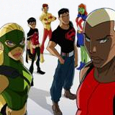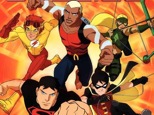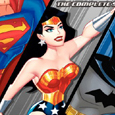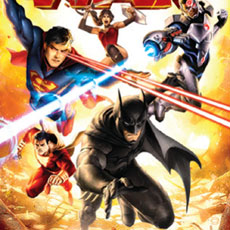The DC Animated Universe has been lauded for maintaining a cohesive continuity through all its shows and remaining true to characters’ personalities/histories from the comics. Another one of its trademarks is the appeal to adults through “dark” and “edgy” plotlines (forgive the clichéd terms). Over the years the shows from Batman: The Animated Series (1992-1995) to the Justice League Unlimited (2004-2006) and the 2010 direct to video movie Batman: Under the Red Hood have always concerned themselves with themes usually reserved for an older audience, though the target group is still the under eighteen crowd.
Over the past ten years, Warner Brothers Animation created other DC cartoons that broke away from the regular continuity to create their own. These include The Batman (2004-2008), Teen Titans (2003-2006), Legion of Superheroes (2006-2008) and Batman: the Brave and the Bold which still runs on the Cartoon Network. Most of these series had the darker themes washed from their plots in order to be kid friendly and have humorous inclination. Another cartoon that strays away from the main DC Animated Universe is called Young Justice, set to air early in 2011. While Young Justice is marketed at the teenage demographic and contains the smart aleck humor that appeals to that group, it has the seriousness of the DC Animated Universe continuity and the possibility of handling those “darker” themes except on a teenage level.
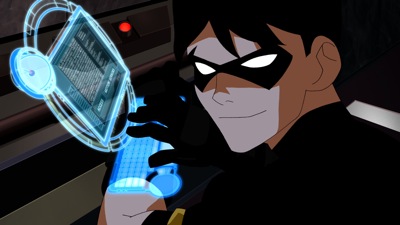 Young Justice takes place on Earth-16, an alternate Earth established in the DC comic book multiverse. The overlaying attitude towards superheroes in this world is that they’re the new, popular craze and are treated much the same way Hollywood stars are. What appears to be a normal crime-fighting day for our heroes—fighting a series of ice-related villains—turns out to be the day when the sidekicks Aqualad, Robin, Kid Flash, and Speedy are taken by their respective mentors Aquaman, Batman, Flash, and Green Arrow to the Hall of Justice. The young heroes believe they are going to be introduced to the hidden mysteries of the Justice League and given full membership. They’re not. The Martian Manhunter gives them a small introduction about the Hall of Justice and then he heads off with other the big headliners to discuss the current ice-villain appearances.
Young Justice takes place on Earth-16, an alternate Earth established in the DC comic book multiverse. The overlaying attitude towards superheroes in this world is that they’re the new, popular craze and are treated much the same way Hollywood stars are. What appears to be a normal crime-fighting day for our heroes—fighting a series of ice-related villains—turns out to be the day when the sidekicks Aqualad, Robin, Kid Flash, and Speedy are taken by their respective mentors Aquaman, Batman, Flash, and Green Arrow to the Hall of Justice. The young heroes believe they are going to be introduced to the hidden mysteries of the Justice League and given full membership. They’re not. The Martian Manhunter gives them a small introduction about the Hall of Justice and then he heads off with other the big headliners to discuss the current ice-villain appearances.
Feeling vexed, Speedy tries to rouse his fellow sidekicks…er…superhero partners to demand equal treatment. He fails miserably and walks out of the Hall of Justice, leaving Robin, Kid Flash, and Aqualad questioning whether his stance was right or not. A potential global disaster calls the Justice League away with Batman ordering the young heroes to stay put. When they ask why they can’t help out, they’re given the same phrase over and over again, “you’re not ready.”
At this point the trio is feeling betrayed by their mentors, so they decide to investigate another disturbance, this time on a more local level, called Project Cadmus. The savvy DC Animated Universe and/or comic book fan will recognize the name as a notorious secret government organization that causes no end of trouble. Robin uses his computer hacking skills to discover that Project Cadmus is a genetics laboratory, seemingly harmless until they visit the place and encounter the Gemomorphs.
Genomorphs are genetically engineered creatures that have various superpowers and are meant to be used as weapons. Not too long after they break in, the trio is captured by the lesser-known hero Guardian, whom they escape and then literary find themselves face to face with Project Cadmus’s ultimate secret project: the Superboy, a Genomorph clone of Superman. While he doesn’t have all the powers of the Man of Steel, his abilities are comparable. Aqualad, Robin, and Kid Flash attempt to persuade Superboy to escape with them to the outside world, but there are many obstacles hindering their path both mental and physical. Whether they overcome them would be giving away too many spoilers.
 I have always found characterization to be DC cartoons’ greatest strength. Warner Brothers Animation does an excellent job portraying DC superheroes as true incarnates of their printed image counterparts, though they are known to take creative liberties. Aqualad is the quiet, thoughtful one and he is one also the oldest members of the team. Unlike Teen Titans where the Boy Wonder led a troupe of young superheroes, Aqualad has the necessary leadership qualities complemented by his mastery over shaping water and generating electrical shocks. Robin provides all the witticisms in this series. This role has is usually given to someone like the Flash or Beast Boy, but it’s fun to see the Boy Wonder take a more light hearted approach to heroics—much like how he was in the Golden Age. This Robin is the Dick Grayson version and he also fulfills the role of techno genius.
I have always found characterization to be DC cartoons’ greatest strength. Warner Brothers Animation does an excellent job portraying DC superheroes as true incarnates of their printed image counterparts, though they are known to take creative liberties. Aqualad is the quiet, thoughtful one and he is one also the oldest members of the team. Unlike Teen Titans where the Boy Wonder led a troupe of young superheroes, Aqualad has the necessary leadership qualities complemented by his mastery over shaping water and generating electrical shocks. Robin provides all the witticisms in this series. This role has is usually given to someone like the Flash or Beast Boy, but it’s fun to see the Boy Wonder take a more light hearted approach to heroics—much like how he was in the Golden Age. This Robin is the Dick Grayson version and he also fulfills the role of techno genius.
Superboy is possibly the most complex character on the team. He’s a clone of the world’s favorite superhero, who also doesn’t want to give him the time of day. Not to mention he doesn’t have much life experience and he decided to journey out into the world during the most stressful period in a person’s life: puberty. Teenage angst sparks will fly in future episodes, but they won’t be generated by heat vision as Superboy doesn’t have that power. Wally West is the chosen Kid Flash and while he does provide a foil for Robin’s quips, I’m not sure what role he plays on the team yet. According to the bio released from Cartoon Network, he eats a lot of food and flirts with the female members of the team, all of which were exempt from the introductory episode.
Miss Martian (mentored by Martian Manhunter) did make an appearance in the last few minutes, but not enough to understand her character. Her profile states she has an eager to please personality, which I deduce will also give her the qualities of a semi-shy girl, well-liked by her teammates. Her powers are telepathy, telekinesis, super strength, shape-shifting, and semi-invisibility. Artemis, Green Arrow’s replacement for Speedy, is the other female member of the team. She’s a regular tough girl with hidden insecurities. I’m guessing these two are going to be similar to Starfire and Raven from Teen Titans. One will be tough and moody, while the other will be bubbly and friendly.
To a degree, these are the standard female personalities found in most cartoons aimed at a largely masculine audience. For diversity’s sake, girls are added to appeal to the female viewers and provide romantic interest for the boys. I bet there are going to be some girl-powered episodes where only Artemis and Miss Martian can save the day, because the boys are captured in some fashion or other. While these do boost the feminine ego, they’re becoming a standard requirement for most DC cartoons and leave the female superheroes to be overshadowed by their male teammates in regular episodes. I can only hope Artemis and Miss Martian are well represented and don’t fall into these traps.
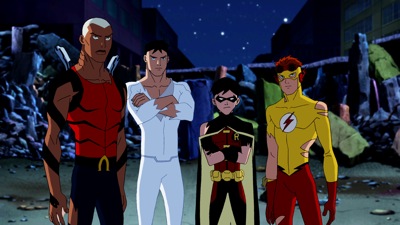 One last note about the female characters, while Miss Martian and Artemis are awesome, it would have been fantastic if one of Wonder Woman’s sidekicks had been added to the team. Donna Troy and Cassandra Sandsmark were both Wonder Girl at some point in the comics and members of the Teen Titans. Either would have been a complimentary addition to the Young Jusitce team.
One last note about the female characters, while Miss Martian and Artemis are awesome, it would have been fantastic if one of Wonder Woman’s sidekicks had been added to the team. Donna Troy and Cassandra Sandsmark were both Wonder Girl at some point in the comics and members of the Teen Titans. Either would have been a complimentary addition to the Young Jusitce team.
Moving onto the voice talent behind the heroes, Khary Payton (voice of Aqualad) is the only veteran from another DC cartoon. He played Cyborg on Teen Titans, an enthusiastic, extrovert half-human, half-machine computer genius. Aqualad is the complete opposite of Cyborg and Payton plays a convincing calm and steady leader of the Young Justice squad.
Jesse McCartney is a pop-singer and the voice of Theodore from both Alvin and the Chipmunk movies. He is a good choice as the purveyor of a less-than-serious Boy Wonder. Nolan North is Superboy and is coming to a DC cartoon after voice-acting mainly for Marvel cartoons. Jason Spisak is most notably recognized from his work on Star Wars: The Clone Wars. Both Nolan and Spisak are decent voice actors and I’m curious how they will develop their characters. Stephanie Lemelin (Artemis) and Danica McKellar (Miss Martian) didn’t get a chance to display their talents. McKellar is best known for her role on the Wonder Years and Lemelin is only starting her voice-acting career. Here’s hoping they portray their superhero characters well.
The animation style is reminiscent of The Batman with sharper lines and angles to give the show that teenage “edgy” style. Most DC cartoons replicate the comics in animation, but Young Justice finds its own appealing art style that makes it stand out from the usual DC fare. Another important note to mention are the producers Greg Weisman and Brandon Veitti. Weisman worked on the groundbreaking cartoon Gargoyles and other DC titles, including The Batman and Batman: The Brave and the Bold. Veitti has spent most of his career at Warner Brothers Animation and his hand has successfully guided the most recent DC cartoons.
DC and Warner Brothers Animation have pulled together yet another surefire win. Young Justice has strong teenage heroes, free of the cliched angst, but relatable to the target audience. They have an experienced production crew and the voice cast will probably prove to be excellent choices for their roles. Warner Brothers Animation is constantly providing the DC canon with fresh, creative ideas and while this series may have its yet to be seen weaknesses, they always overcome them. It’s one of the main reasons DC cartoons always endure. Young Justice is dramatic, adventurous, exciting, and enjoyable. There’s nothing much left to write, other than I hope they have some creative plots in store for the female characters.
 | Young Justice Cartoon Network January 7, 2011 60 minutes (30 minute episodes) Rated TV PG Directed by Jay Oliva (Part 1) and Sam Liu (Part 2) | |


